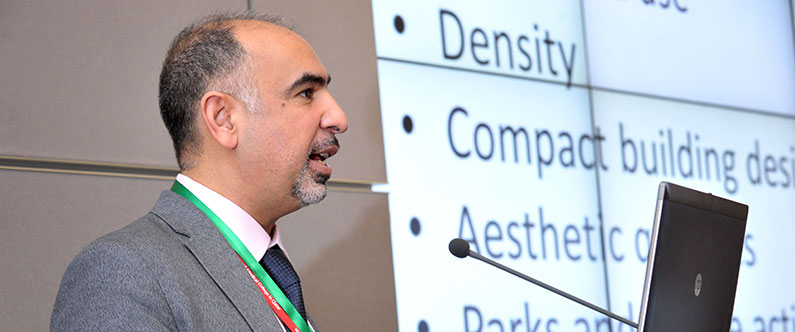The role buildings play in promoting – or damaging – health
 Dr. Shahrad Taheri, Professor of Medicine and Assistant Dean for Clinical Investigations, says the built environment can play a key role in promoting health and wellbeing.
Dr. Shahrad Taheri, Professor of Medicine and Assistant Dean for Clinical Investigations, says the built environment can play a key role in promoting health and wellbeing.
WCM-Q’s Shahrad Taheri spoke about the significant impact the built environment has on health on the first day of Qatar Sustainability Week.
Dr. Taheri, Professor of Medicine and Assistant Dean for Clinical Investigations, said that research has shown that the layout of towns and cities and the quality of individual buildings can affect our feelings of wellbeing, stress levels, how much exercise we take, our quality of sleep, the quality of the air we breathe and many other factors that determine our overall health and wellbeing.
The built environment therefore plays a key role in the prevalence of lifestyle-related conditions such as obesity, type-2 diabetes and cardiovascular disease, among others, he explained.
Speaking at the Qatar Green Building Conference, held at Qatar National Convention Centre Dr. Taheri said:
“We spend an average of 20 hours per day inside buildings and the quality of the built environment around us has been proven to have important effects on our happiness and health. If we are to reverse the trend of increasing rates of obesity and type-2 diabetes, which are some of the most pressing health issues facing us today, it is crucial we understand how we can use good design and planning to encourage good health.”
Qatar Sustainability Week, held 13-19 November, is an initiative of Qatar Green Building Council and provides opportunities for the community to engage in a wide range of sustainability-oriented activities.
 Dr. Taheri, an expert on obesity, diabetes and the science of sleep, said that the plentiful availability of green space, good public transport links, walkable urban environments, good air quality and protection from noise pollution all positively impact health.
Dr. Taheri, an expert on obesity, diabetes and the science of sleep, said that the plentiful availability of green space, good public transport links, walkable urban environments, good air quality and protection from noise pollution all positively impact health.
“If people are able to walk from their home to work, from their work to the shops, and from their child’s school to the park they will naturally take more exercise each day,” he said. “Similarly, if we can use public transport to travel widely around a city we naturally walk more than if we just take the car from A to B. These small amounts of physical activity that we take by walking from place to place really do add up and you would be surprised what a positive impact this has on the health of the whole community.
“Additionally, good quality housing with low levels of ambient noise help us to get a good night’s sleep, which also has a very significant positive impact on health.”
Dr. Taheri praised the construction of Qatar’s metro system, the steadily growing number of parks and green spaces, and the intelligent design of the Msheireb Downtown Doha project, currently under construction, which will feature a web of interconnected, covered pedestrian walkways to allow people to travel through the district easily and comfortably without using their car.
Dr. Taheri also praised Qatar Green Building Council for incorporating the health of the community into its understanding of sustainable building design and urban planning.
He said: “It is often overlooked just how much buildings impact our health but a well-designed city with aesthetically pleasing, well ventilated buildings helps us to breathe clean air, sleep better, feel less stressed, walk more and to be happier and healthier.”